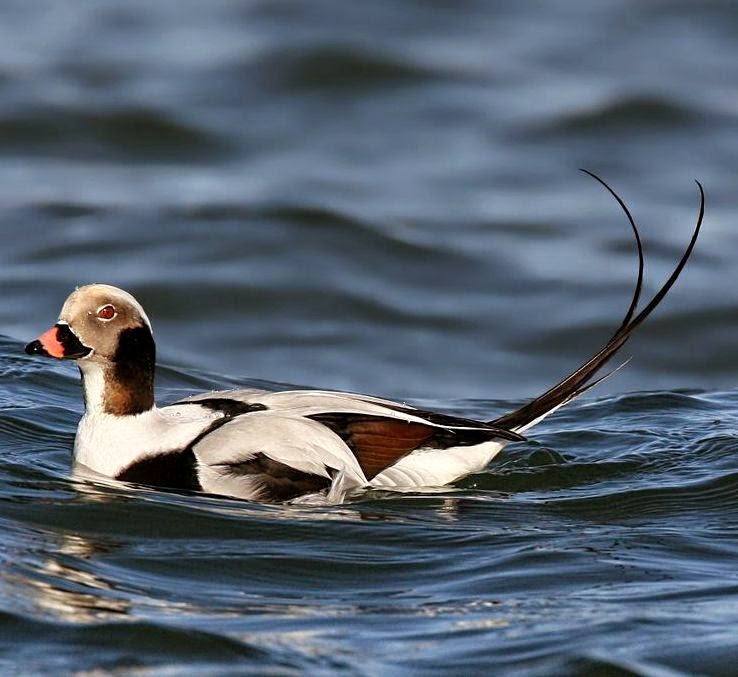 |
| Photo by Wolfgang Wander (Wikipedia) |
Common name:
long-tailed duck (en); pato-de-cauda-afilada (pt); harelde kakawi (fr); pato havelda (es); eisente (de)
Taxonomy:
Order Anseriformes
Family Anatidae
Range:
This species breeds in northernmost latitudes of Eurasia and North America, from Iceland, Scandinavia and the Baltic, throughout northern Russia, and into Alaska, northern Canada and western and southern Greenland. They migrate south along the coasts of the Atlantic and the Pacific, as far south as the British Isles, Korea and northern Japan, south-western British Columbia and Virginia.
Size:
These birds are sexually dimorphic, with males being larger than females. The males are 51-60 cm long, including the 15 cm long tail, and weigh 650-900 g. Females are 37-47 cm long and weigh 550-800g. They have a wingspan of 73-79 cm.
Habitat:
The long-tailed duck breeds on small tundra lakes, pools, bogs, rivers, tundra grasslands and coastal sites of the high Arctic. Outside the breeding season they are mostly found at sea, usually in shallow offshore waters, but also in estuaries, brackish lagoons and freshwater lakes.
Diet:
They feed mainly on crustaceans, molluscs, and other marine invertebrates such as echinoderms and worms, but also fishes, insects and plant material such as algae, grasses, and the seeds and fruits of tundra plants.
Breeding:
Long-tailed ducks are monogamous and breed in May-August. They nest in a bowl-shaped scrape on the ground, made by the female and lined with grasses, leaves and feather down. It is usually placed on dry ground, hidden among rocks or under plant growth. The female lays 5-10 pale grey to olive eggs, which she incubates alone for 24-30 days while the male helps defend the nest. During the incubation period the males leave and begin moulting, and female must finish incubation alone. The chicks leave the nest soon after hatching and are able to feed themselves, but rely on the females for protection. They start flying at 35-40 days of age. They reach sexual maturity at 2 years of age.
Conservation:
IUCN status – VU (Vulnerable)
This species has a very large breeding range and a global population estimated at 6,2-6,8 million individuals, but the population has declined dramatically in recent decades, especially in the Baltic, overall possibly declining by 50% over the last 3 decades. The long-tailed duck is threatened by wetland habitat degradation and loss from petroleum pollution, wetland drainage and peat-extraction, while also suffering direct mortality from oil pollution, drowning through entanglement in fishing nets, hunting on migration routes over certain regions of the Arctic, and outbreaks of avian cholera. Changes in the natural cycles of the Arctic, due to climate change, have also possibly reduced the breeding success of this species, as declines in rodent populations force predators to increase pressure on young birds.







